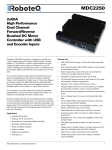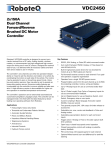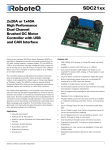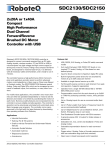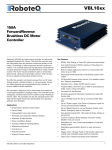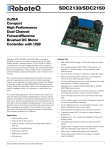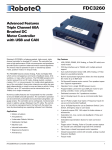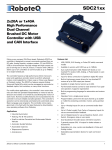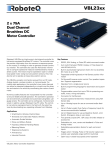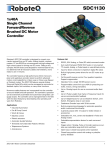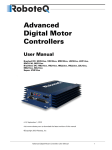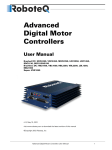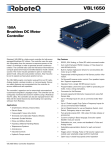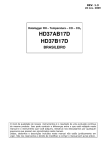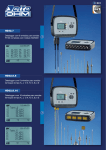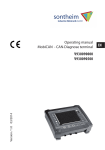Download MDC22xx Motor Controller Datasheet
Transcript
MDC2xxx 2x60A High Performance Dual Channel Forward/Reverse Brushed DC Motor Controller with USB, CAN and Encoder Inputs Roboteq’s MDC2xxx controller is designed to convert commands received from an RC radio, Analog Joystick, wireless modem, PC (via RS232 or USB) or microcomputer into high voltage and high current output for driving one or two DC motors. Designed for maximal ease-of-use, it is delivered with all necessary cables and hardware, and is ready to use in minutes. Using CAN bus, up to 127 controllers can be networked at up to 1Mbit/s on a single twisted pair. Features List • The controller features a high-performance 32-bit microcomputer and quadrature encoder inputs to perform advanced motion control algorithms in Open Loop or Close Loop (Speed or Position) modes. The MDC2xxx features several Analog, Pulse and Digital I/Os which can be remapped as command or feedback inputs, limit switches, or many other functions. Built-in high-power power drivers for two brushed DC motors at up to 60A output per channel • • Orderable as single channel version up to 120A The controller’s two motor channels can either be operated independently or mixed to set the direction and rotation of a vehicle by coordinating the motion of each motor. Numerous safety features are incorporated into the controller to ensure reliable and safe operation. The controller's operation can be extensively automated and customized using Basic Language scripts. The controller can be reprogrammed in the field with the latest features by downloading new operating software from Roboteq. Applications • • • • • • • • • USB, RS232, 0-5V Analog, or Pulse (RC radio) command modes • • CAN bus interface up to 1Mbit/s • • Terrestrial and Underwater Robotic Vehicles Automatic Guided Vehicles Police and Military Robots Operates from a single power source Programmable current limit for each channel up to 2x60A for protecting controller, motors, wiring and battery Built-in programming language for automation and customization • Up to 4 Analog Inputs for use as command and/or feedback • Up to 5 Pulse Width, Duty Cycle or Frequency Inputs for use as command and/or feedback • Up to 6 Digital Inputs for use as Deadman Switch, Limit Switch, Emergency stop or user inputs • • Dual Quadrature Encoder inputs with 32-bit counters 2 general purpose 40V, 1A output for brake release or accessories • Selectable min, max, center and deadband in Pulse and Analog modes • Selectable exponentiation factors for each command inputs • Trigger action if Analog, Pulse or Encoder capture are outside user selectable range (soft limit switches) • Open loop or closed loop speed control operation Flight simulators Telepresence Systems Full forward & reverse control on each channel. Four quadrant operation. Supports regeneration • Industrial Automation Tracking, Pan & Tilt systems Auto switch between USB, RS232, CAN, Analog, or Pulse based on user-defined priority Animatronics MDC2xxx Motor Controller Datasheet 1 • Closed loop position control with analog or pulse/frequency feedback • Stall detection and selectable triggered action if Amps is outside user-selected range • Precise speed and position control when Encoder feedback is used Short circuit protection with selectable sensitivity levels • • PID control loop with separate gains for each channel • • • Optional Mixed control (sum and difference) for tank-like steering • Configurable Data Logging of operating parameters on RS232 Output for telemetry or analysis • • Built-in Battery Voltage and Temperature sensors • • • Overvoltage and Undervoltage protection Programmable Watchdog for automatic motor shutdown in case of command loss Overtemperature protection Diagnostic LED Open frame or enclosed design with heat conducting bottom plate Optional 12V backup power input for powering safely the controller if the main motor batteries are discharged • • Efficient heat sinking. Operates without a fan in most applications Power Control wire for turning On or Off the controller from external microcomputer or switch Power wiring 0.25" Faston tabs • • No consumption by output stage when motors stopped • • • • • Regulated 5V output for powering Encoders, RC radio, RF Modem or microcomputer • Separate Programmable acceleration and deceleration for each motor • Separate Programmable maximum forward and reverse power • • Support for CANopen and two simplified CAN protocols • 5.5” (139.7mm) L, 5.5” W (139.7mm), 1.0” (25mm) H -40o to +85o C operating environment 0.5 lbs (250g) Easy configuration, tuning and monitory using provided PC utility Field upgradeable software for installing latest features via the internet Ultra-efficient 3 mOhm High-Efficiency version ON resistance MOSFETs Orderable Product References TABLE 1. 2 Reference Number of Channels Amps/Channel Volts Cooling MDC2230 2 60 30 Conduction Plate MDC2230S 1 120 30 Conduction Plate MDC2250 2 60 50 Conduction Plate MDC2250S 1 120 50 Conduction Plate MDC2460 2 60 60 Conduction Plate MDC2460S 1 120 60 Conduction Plate MDC2xxx Motor Controller Datasheet Version 1.3. April 05, 2014 Power Wires Identifications and Connection Important Safety Disclaimer Dangerous uncontrolled motor runaway condition can occur for a number of reasons, including, but not limited to: command or feedback wiring failure, configuration error, faulty firmware, errors in user script or user program, or controller hardware failure. The user must assume that such failures can occur and must make his/her system safe in all conditions. Roboteq will not be liable in case of damage or injury as a result of product misuse or failure. Power Wires Identifications and Connection The diagram below shows how to wire the controller and how to turn power On and Off. F2 1A SW1 Main On/Off Switch 1A PwrCtrl Note 1 M1+ Ground Motor 1 Backup Battery M1Diode >20A Resistor 1K, 0.5W Note 3 VMot VMot F1 Note 4 + M2+ Note 2 Motor 2 SW2 Emergency Contactor or Cut-off Switch - M2- Ground Ground I/O Connector Main Battery Note 5 Do not Connect! FIGURE 8. Powering the controller. Thick lines identify MANDATORY connections Important Warning Carefully follow the wiring instructions provided in the Power Connection section of the User Manual. The information on this datasheet is only a summary. Mandatory Connections It is imperative that the controller is connected as shown in the above diagram in order to ensure a safe and trouble-free operation. All connections shown as thick black lines are mandatory. The controller must be powered On/ Off using switch SW1on the Power Control Header. Use a suitable high-current fuse F1 as a safety measure to prevent damage to the wiring in case of major controller malfunction. MDC2xxx Motor Controller Datasheet 3 Emergency Switch or Contactor The battery must be connected in permanence to the controller’s VMot power via an input emergency switch or contactor SW2 as additional safety measure. The user must be able to deactivate the switch or contactor at any time, independently of the controller state. Precautions and Optional Connections Note 1: Backup battery to ensure motor operation with weak or discharged batteries, connect a second battery to the Power Control wire/terminal via the SW1 switch. Note 2: Use precharge 1K, 0.5W Resistor to prevent switch arcing. Note 3: Insert a high-current diode to ensure a return path to the battery during regeneration in case the fuse is blown. Note 4: Optionally ground the VMot tabs when the controller is Off if there is any concern that the motors could be made to spin and generate voltage in excess of 30V (MDC2230), 50V (MDC2250) or 60V (MDC2460). Note 5: Beware not to create a path from the ground pins on the I/O connector and the battery minus terminal. Use of Safety Contactor for Critical Applications An external safety contactor must be used in any application where damage to property or injury to person can occur because of uncontrolled motor operation resulting from failure in the controller’s power output stage. F2 1A SW1 Main On/Off Switch 1A PwrCtrl Ground Resistor 1K, 0.5W Diode >20A F1 VMot Digital Out to +40V Max I/O Connector + Ground Main Battery FIGURE 9. Contactor wiring diagram The contactor coil must be connected to a digital output configured to activate when “No MOSFET Failure”. The controller will automatically deactivate the coil if the output is expected to be off and battery current of 1A or more is measured for more than 0.5s. This circuit will not protect against other sources of failure such as those described in the “Important Safety Disclaimer” on page 3. 4 MDC2xxx Motor Controller Datasheet Version 1.3. April 05, 2014 Single Channel Motor Wiring Single Channel Motor Wiring The single channel version of the controller (MDC2230S/MDC2250S/MDC2460S) requires that the output be parallel and that the load be wired as shown in the diagram below. M VMOT M1- M1+ GND M2- M2+ VMOT FIGURE 10. MDC2230S/MDC2250S/MDC2460S wiring diagram Important Warning This wiring is only possible on controllers fitted with the Single Channel version of the controller logic. Dual channel controllers will be damaged if wired as single channel. Verify that the PC utility identifies the controller as MDC2230S/MDC2250S/MDC2460S before applying power to the load. Encoder Wiring The encoder connector is a 6-pin Molex Microfit 3.0, model 43645. Pin assignment is in the table below. 6 1 6 1 FIGURE 11. Encoder connector TABLE 4. Pin Number 1 2 3 4 5 6 Signal 5Vout Enc1A Enc1B Enc2A Enc2B GND Controller Mounting During motor operation, the controller will generate heat that must be evacuated. The published amps rating can only be fully achieved if adequate cooling is provided. Mount the controller so that the bottom plate makes contact with a metallic surface (chassis, cabinet) to conduct the heat. MDC2xxx Motor Controller Datasheet 5 Commands and I/O Connections Connection to RC Radio, Microcomputer, Joystick and other low current sensors and actuators is done via the 15 connector located in front of the board. The functions of many pins vary depending on user configuration. Pin assignment is found in the table below. 8 1 15 9 FIGURE 12. Connector pin locations TABLE 5. Connector Pin Power 1 Dout Com RC Ana Dinput DOUT1 9 Motor Brake DOUT2 2 Safety Contactor TxOut 10 RS232Tx RC5 3 ANA1 DIN5 RxIn 11 ANA4 RC1 12 AnaCmd1 (1) RS232Rx RC4 4 5 Default Config RC3 ANA3 DIN4 AnaCmd2 (1) DIN1 RCRadio1 DIN3 Unused GND 13 GND 6 14 CANL CAN Low CANH CAN High 5VOut 7 15 8 RC2 ANA2 DIN6 Unused DIN2 RCRadio2 Note 1: Analog command is disabled in factory default configuration. Default I/O Configuration The controller can be configured so that practically any Digital, Analog and RC pin can be used for any purpose. The controller’s factory default configuration provides an assignment that is suitable for most applications. The figure below shows how to wire the controller to two analog potentiometers, an RC radio, and the RS232 port. It also shows how to connect the two outputs to motor brake solenoids. You may omit any connection that is not required in your application. The controller automatically arbitrates the command priorities depending on the presence of a valid command signal in the following order: 1-RS232, 2-RC Pulse, 3-None. If needed, use the Roborun+ PC Utility to change the pin assignments and the command priority order. 6 MDC2xxx Motor Controller Datasheet Version 1.3. April 05, 2014 Enabling Analog Commands RC Ch2 2 RC Ch1 RS232 Ground TxOut RxIn 1 8 1 Motor Brake Safety Contactor 15 9 Pot 2 Pot 1 FIGURE 13. Factory default pins assignment Enabling Analog Commands For safety reasons, the Analog command mode is disabled by default. To enable the Analog mode, use the PC utility and set Analog in Command Priority 2 or 3 (leave Serial as priority 1). Note that by default the additional securities are enabled and will prevent the motor from starting unless the potentiometer is centered, or if the voltage is below 0.25V or above 4.75V. The drawing shows suggested assignment of Pot 1 to ANA1 and Pot 2 to ANA4. Use the PC utility to enable and assign analog inputs. CAN Bus Operation The controller can interface to a standard CAN Bus network, using 3 possible protocols: Standard CANOpen, and two simplified proprietary schemes (MiniCAN and RawCAN). Please refer to the User Manual for details. USB and CAN cannot operate at the same time. The controller starts up with CAN available, but CAN will be disabled as soon as the controller is plugged into USB. To re-enable CAN, disconnect USB and restart the controller. USB communication Use USB only for configuration, monitoring and troubleshooting. USB is not a reliable communication method when used in a electrically noisy environments and communication will not always recover after it is lost without unplugging and replugging the connector, or restarting the controller. Always prefer RS232 communication when interfacing to a computer. MDC2xxx Motor Controller Datasheet 7 Status LED Flashing Patterns After the controller is powered on, the Power LED will turn on, indicating that the controller is On. The Status LED will be flashing at a 2 seconds interval. The flashing pattern provides operating or exception status information. Idle - Waiting for Command RS232/USB Mode RC Pulse Mode Analog Mode FIGURE 14. Normal Operation Flashing Patterns Short Detected Overheat Under or Over Voltage Power Stage Off FIGURE 15. Exception or Fault Flashing Patterns Additional status information may be obtained by monitoring the controller with the PC utility. Self-Test and Reset Default Configuration It is possible to verify that the controller is functioning by activating a self-test that will in turn ramp the motor(s) up to full forward power and down to full reverse power. Then it toggles each digital output. To activate self-test, turn off the controller, short RS232 Rx and Tx pins together (Pins 2 and 3 of I/O connector), and turn the controller on again. The process will repeat until power is turned off and the RS232 is no longer shorted. Activating the selftest also resets the controller settings to factory defaults. Note: RS232 cannot be connected to PC as this will prevent the controller from entering the self-test mode. Electrical Specifications Absolute Maximum Values The values in the table below should never be exceeded, permanent damage to the controller may result. TABLE 6. 8 Parameter Measure point Battery Leads Voltage Ground to VMot Model Min Typ Max Units MDC2230 35 Volts MDC2250 50 Volts MDC2460 62 Volts Reverse Voltage on Battery Leads Ground to VMot All Power Control Voltage Ground to Pwr Control wire All MDC2xxx Motor Controller Datasheet -1 Volts 50 Volts Version 1.3. April 05, 2014 Electrical Specifications TABLE 6. Parameter Measure point Model Motor Leads Voltage Ground to M1+, M1-, M2+, M2- Min Typ Max Units MDC2230 30 Volts MDC2250 50 (1) Volts MDC2460 62 (1) Volts Digital Output Voltage Ground to Output pins All 30 Volts Analog and Digital Inputs Voltage Ground to any signal pin on 15-pin and encoder connectors All 15 Volts RS232 I/O pins Voltage External voltage applied to Rx/ Tx pins All 15 Volts Temperature Board All 85 oC Humidity Board All 100 (2) % -40 Note 1: Maximum regeneration voltage in normal operation. Never inject a DC voltage from a battery or other fixed source Note 2: Non-condensing Power Stage Electrical Specifications (at 25oC ambient) TABLE 7. Parameter Measure point Models Min Battery Leads Voltage Ground to VMot MDC2230 MDC2250 Motor Leads Voltage Ground to M1+, M1-, M2+, M2- Max Units 0 (1) 30 Volts 0 (1) 50 Volts MDC2460 0 (1) 62 Volts MDC2230 0 (1) 30 (2) Volts MDC2250 50 (2) Volts MDC2460 62 (2) Volts 50 Volts Power Control Voltage Ground to Power Control wire All 0 (1) Minimum Operating Voltage VMot or Pwr Ctrl wires All 9 (3) Idle Current Consumption VMot or Pwr Ctrl wires All 50 ON Resistance VMot to M+, plus Mto Ground at 100% power. Per channel All Max Current per channel for 30s Motor current Continuous Max Current per channel Motor current Current Limit range Ch1 or Ch2 Motor current MDC2230/50/60 10 MDC2230S/ 50S/60S Ch1 or Ch2 Motor current Stall Detection Amps range MDC2xxx Motor Controller Datasheet Typ Volts 100 (4) 150 6 mA mOhm MDC2230/50/60 60 (5) Amps MDC2230S/ 50S/60S 120 (5)(6) Amps MDC2230/50/60 100(6)(7) Amps MDC2230S/ 50S/60S 100 (6)(7) Amps 50 (8) 60 Amps 10 100 (8) 120 (6) Amps MDC2230/50/60 10 60 (8) 60 Amps MDC2230S/ 50S/60S 10 120 (8) 120 (6) Amps 9 TABLE 7. Parameter Measure point Models Min Typ Max Units Stall Detection timeout range Ch1 or Ch2 Motor current All 1 65000 (9) 65000 milliseconds Short Circuit Detection threshold (10) Between Motor wires or Between Motor wire and Ground MDC2230/50/60 140 (11) 400 (11) Amps MDC2230S/ 50S/60S 280 800 Amps Short Circuit Detection threshold Between Motor wires and VMot All No Protection. Permanent damage will result Motor Acceleration/Deceleration range Ch1 or Ch2 All 100 500 (12) 65000 milliseconds Note 1: Negative voltage will cause a large surge current. Protection fuse needed if battery polarity inversion is possible Note 2: Maximum regeneration voltage in normal operation. Never inject a DC voltage from a battery or other fixed source Note 3: Minimum voltage must be present on VMot or Power Control wire Note 4: Current consumption is lower when higher voltage is applied to the controller’s VMot or PwrCtrl wires Note 5: Max value is determined by current limit setting. Duration is estimated and is dependent on ambient temperature cooling condition Note 6: Current is sum of both synchronized channels. Current must be balanced between channel to obtain max current. Note 7: Estimate. Limited by case temperature. Current may be higher with better cooling Note 8: Factory default value. Adjustable in 0.2A increments Note 9: Factory default value. Time in ms that Stall current must be exceeded for detection Note 10: Controller will stop until restarted in case of short circuit detection Note 11: Sensitivity selectable by software Note 12: Factory default value. Time in ms for power to go from 0 to 100% Command, I/O and Sensor Signals Specifications TABLE 8. 10 Parameter Measure point Min Typ Max Units Main 5V Output Voltage Ground to 5V pins on 4.6 4.75 4.9 Volts 5V Output Current 5V pins on Hall Connector and DSub15 200 (1) mA Digital Output Voltage Ground to Output pins 40 Volts Digital Output Current Output pins, sink current 1 Amps Output On resistance Output pin to ground 0.75 1.5 Ohm Output Short circuit threshold Output pin 1.4 1.75 Input Impedances AIN/DIN Input to Ground Digital Input 0 Level Ground to Input pins -1 1 Volts Digital Input 1 Level Ground to Input pins 3 15 Volts Analog Input Range Ground to Input pins 0 Analog Input Precision Ground to Input pins 0.5 % Analog Input Resolution Ground to Input pins 1 mV Pulse durations Pulse inputs 20000 Pulse repeat rate Pulse inputs 50 Pulse Capture Resolution Pulse inputs Frequency Capture Pulse inputs MDC2xxx Motor Controller Datasheet 1.05 Amps 53 kOhm 5.1 Volts 10 us 250 Hz 1 100 us 10000 Hz Version 1.3. April 05, 2014 Electrical Specifications TABLE 8. Parameter Measure point Min Encoder count Internal -2.147 Encoder frequency Encoder input pins Typ Max Units 2.15 10^9 Counts 250 kHz Note 1: Sum of all 5VOut outputs Operating & Timing Specifications TABLE 9. Parameter Measure Point Command Latency Command to output change PWM Frequency Ch1, Ch2 outputs Closed Loop update rate Internal USB Rate USB pins RS232 baud rate Rx & Tx pins RS232 Watchdog timeout Rx pin Min 10 Typ Max Units 0.5 1 ms 18 (1) 20 kHz 1000 Hz 12 115200 (2) MBits/s Bits/s 1 (3) 65000 ms Note 1: May be adjusted with configuration program Note 2: 115200, 8-bit, no parity, 1 stop bit, no flow control Note 3: May be disabled with value 0 Scripting TABLE 10. Parameter Measure Point Scripting Flash Memory Internal Max Basic Language programs Internal Min Typ Max 8192 1000 Units Bytes 1500 Lines Integer Variables Internal 1024 Words (1) Boolean Variables Internal 1024 Symbols Execution Speed Internal 100 000 Lines/s 50 000 Note 1: 32-bit words Thermal Specifications TABLE 11. Parameter Measure Point Model Min Max Units Board Temperature Heatsink plate All -40 Typ 85 (1) oC Thermal Protection range Heatsink plate All 80 90 (2) oC Power Dissipation Case All 30 Watts Thermal resistance Power MOSFETs to heatsink All 2 oC/W Note 1: Thermal protection will protect the controller power Note 2: Max allowed power out starts lowering at minimum of range, down to 0 at max of range MDC2xxx Motor Controller Datasheet 11 Mechanical Specifications TABLE 12. Parameter Measure Point Min Typ Max Units Weight Board 250 (0.5) g (lbs) Power Connectors width Terminal tab 0.25 Inches 0.1" (2.5 mm) 0.25" 0.98" (25mm) (6.3 mm) 0.57" 0.7" (17.8mm) 0.3" (14.5mm) (7.6 mm) 0.16" (4.0mm) 0.325" (8.3 mm) FIGURE 16. MDC2xxx side view and dimensions 5.50" (139.7mm) 5.25" (133.4mm) 0.120" (3.0mm) 0.15" (3.8mm) 0.120" (3.0mm) 0.40" (10.2mm) 0.3" (7.6mm) 2.32" (59.0mm) 2.0" (5.08mm) 4.20" (106.7mm) 0.3" (7.6mm) 0.2" (5.1mm) 0.2" (5.1mm) 0.6" (10.11mm) 1.09" 0.35" (8.9mm) 0.15" (3.8mm) 5.00" (127.0mm) 5.50" (139 .7mm) 0.35" (8.9mm) 2.75" (69.9mm) 0.24" (6.0mm) 0.65" (16.1mm) 0.40" (10.2mm) 0.15" (3.8mm) (3.8mm) 0.15" (3.8mm) 0.65" (16.1mm) 3.42" (86.9mm) 1.25" (31.8mm) 3.00" (76.2mm) FIGURE 17. MDC2xxx top view and dimensions 12 MDC2xxx Motor Controller Datasheet Version 1.3. April 05, 2014












